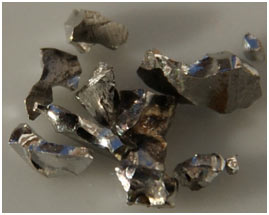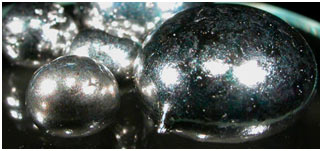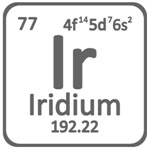An Introduction to Iridium Element
Iridium is the transition element located in group number 9 and period number 6 of the periodic table.
- Its atomic number is 77 and its atomic mass is 192.217.
- A single atom of iridium contains 77 electrons.
- The nucleus of iridium contains 116 neutrons.
- It is chemically represented by the symbol “Ir”.
Naming and History
The name iridium is derived from the Greek word “Iris”. This was the name of the Greek Goddess of the rainbow. It was named because of its highly colored salts.
- Smithson Tennant
In 1803, an English chemist Smithson Tennant discovered iridium, who also discovered osmium at the same time.
He dissolved platinum in aqua regia – the mixture of nitric acid and hydrochloric acid and heated it till the solution. The black residue left was thought to be graphite but the tenant had working experience with carbon so he thought differently.
He prepared alkaline and acidic solutions of that residue and found two elements. Iridium was one of the two.
- Humphry Davy
In 1813, sir Humphry Davy proved that iridium can be melted like other metals. He used an array of batteries for this purpose so a powerful current could be generated.

Occurrence of Iridium
Iridium is found in an uncombined state in nature. It has been observed that dating rocks between cretaceous and tertiary periods contain iridium. The major ores containing iridium are iridosmine and osmiridium. The major supplier of iridium is south Africa. It is also obtained as a by-product of nickel mining.
Properties of Iridium
Iridium is a silverish-whitish, hard, very brittle when pure, corrosion resistant, lustrous, and very dense rare transition metal. It is very unreactive and highly resists the attacks of acids and water. It is the most corrosion-resistant metal.
Molten salts such as sodium cyanide r sodium chloride can attack iridium. It is the second most dense metal after osmium. The melting point of iridium is 2446°C and its boiling point is 4428°C. It has a density of 22.42 grams per cubic centimeter. It exists in the solid phase at room temperature.

Biological importance of Iridium
There is no known function of iridium in living organisms and is considered to be very less toxic. The powdered iridium, however, is a fire hazard and considered as irritating agent.
Uses of Iridium
- Pure iridium is so brittle that it can not be machined. So, it is mostly alloyed with other metals. Iridium is alloyed with platinum to make it hard.
- These alloys are used to make high-temperature equipment and crucibles.
- Osmium and iridium alloys are used for nibs of high-quality fountain pens and bearings of the compass.
- It is used as a catalyst in the chemical industry.
- In the automotive and electronic industry, iridium is used to coat electrodes in Chlor-alkali process.
- Due to its low reactivity, it is widely used in spark plugs and electrical contacts.
- Due to its highly corrosion-resistant nature, it was used as a standard meter bar.
- It is also used in the jewelry industry.
Isotopes of Iridium
There are almost 34 known isotopes of iridium whose mass number ranges from 165 to 198. The most stable and common is basically a mixture of two isotopes: Ir- 191 and Ir- 193. The abundance of the former is 37 % and the latter is 62.7 %.
- The radioisotopes of iridium are used in the diagnosis and treatment of cancer.
MCQs:
- What is the atomic number of iridium?
- A) 76
- B) 77
- C) 78
- D) 79
- Answer: B) 77
- Who discovered iridium?
- A) Humphry Davy
- B) Smithson Tennant
- C) Marie Curie
- D) Dmitri Mendeleev
- Answer: B) Smithson Tennant
- What is the major supplier of iridium?
- A) Russia
- B) United States
- C) South Africa
- D) China
- Answer: C) South Africa
- Which of the following is NOT a property of iridium?
- A) Corrosion resistance
- B) Highly reactive
- C) Dense
- D) Lustrous
- Answer: B) Highly reactive
- How many electrons does a single atom of iridium contain?
- A) 76
- B) 77
- C) 116
- D) 192
- Answer: B) 77
- What is the boiling point of iridium?
- A) 2000°C
- B) 3000°C
- C) 4000°C
- D) 4428°C
- Answer: D) 4428°C
- Which metal is often alloyed with iridium to make it hard?
- How is iridium primarily obtained?
- A) Extraction from seawater
- B) Synthesis in laboratories
- C) By-product of nickel mining
- D) Mining from lunar rocks
- Answer: C) By-product of nickel mining
- What is the biological importance of iridium?
- A) Essential for human life
- B) Highly toxic
- C) Unknown function in living organisms
- D) Necessary for plant growth
- Answer: C) Unknown function in living organisms
- Which industry commonly uses iridium as a catalyst?
- A) Agricultural
- B) Pharmaceutical
- C) Chemical
- D) Construction
- Answer: C) Chemical
- What is the most stable isotope of iridium?
- A) Ir-191
- B) Ir-193
- C) Ir-198
- D) Ir-165
- Answer: A) Ir-191
- How many known isotopes of iridium are there?
- A) 20
- B) 30
- C) 34
- D) 40
- Answer: C) 34
- What process is iridium commonly used in electrodes for in the automotive and electronic industry?
- A) Aluminum refining
- B) Chlor-alkali process
- C) Polymerization
- D) Desalination
- Answer: B) Chlor-alkali process
- What is the primary use of iridium in the jewelry industry?
- A) Rings
- B) Necklaces
- C) Earrings
- D) Alloying with platinum
- Answer: D) Alloying with platinum
- Who proved that iridium can be melted like other metals?
- A) Marie Curie
- B) Dmitri Mendeleev
- C) Smithson Tennant
- D) Humphry Davy
- Answer: D) Humphry Davy
- Which element is iridium commonly alloyed with for high-quality fountain pen nibs?
- A) Gold
- B) Silver
- C) Platinum
- D) Copper
- Answer: C) Platinum
- What is the melting point of iridium?
- A) 2000°C
- B) 3000°C
- C) 4000°C
- D) 2446°C
- Answer: D) 2446°C
- How is iridium primarily found in nature?
- What are the two most stable isotopes of iridium?
- A) Ir-191 and Ir-192
- B) Ir-192 and Ir-193
- C) Ir-191 and Ir-193
- D) Ir-193 and Ir-194
- Answer: C) Ir-191 and Ir-193
Summary: Iridium Element
In conclusion, iridium, a transition element with atomic number 77, exhibits remarkable properties and diverse applications. Named after the Greek goddess Iris due to its colorful salts, it was discovered by Smithson Tennant in 1803 and further studied by Humphry Davy in 1813.
Occurrence of Iridium:
- Iridium occurs naturally in uncombined states and ores like iridosmine and osmiridium, primarily found in South Africa and as a by-product of nickel mining.
Properties of Iridium:
- Known for its corrosion resistance and density, iridium is the second most dense metal after osmium. It has a melting point of 2446°C and a boiling point of 4428°C.
Biological Importance:
- While its biological role remains uncertain, iridium is considered to be very less toxic, although powdered iridium can pose fire hazards and irritate the skin.
Uses:
- Iridium is extensively used in alloying with platinum for industrial purposes, high-temperature equipment, chemical catalysis, spark plugs, and even jewelry due to its corrosion resistance and density.
Isotopes:
- There are almost 34 known isotopes of iridium, with Ir-191 and Ir-193 being the most stable and common. These isotopes find applications in medical fields such as cancer diagnosis and treatment.
Overall, iridium’s unique properties and versatile applications underscore its significance in various fields of science and industry.

